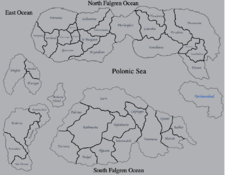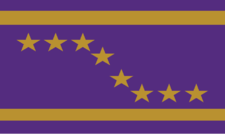Urshawabad
The Muhadi People's Republic of Urshawabad | |
|---|---|
| Est. 2032 | |
|
Flag | |
 | |
| Official languages | Ursha |
| Ethnic groups | Quomorac Darbulis Raphans Komarlanians |
| Religion | Muhadism |
| Demonym(s) | Urshawan |
| Government | People's Republic |
| Undecided Name | |
| The Holy Vizier of the Muhad and the Quomorac | |
| History | |
| 147 A.F. | |
| 224 A.F. | |
| 341 A.F. | |
| 430 A.F. | |
| 707 A.F. | |
| 736 A.F. | |
| 971 A.F. | |
| 1738 A.F. | |
| 1898 A.F. | |
| 1959 A.F. | |
| 1978 A.F. | |
| 2032 A.F. | |
The Muhadi People's Republic of Urshawabad, commonally known as Urshawabad is a large nation with a rich history. One of the first continents to establish central government, Urshawabad today is sparsely populated, highly educated, growing urban centers, and world class science, technology and engineering universities and research centers. Urshawabad today is led by a Prime Minister, but is also the religious capitol and origin state for Muhadism, with it's religious leader centered in the capitol of ___, The Holy Vizier of the Muhad and the Quomorac.
Contents
- 1 History
- 1.1 First government and centralized power
- 1.2 Centralized Power and The Quomora Lands of Urshawabad (147-224)
- 1.3 The Muszabajjiq Empire of Urshawabad (224-341)
- 1.4 The Dorume Tribal Empire of Urshawabad (341-430)
- 1.5 The Rapha Holy Empire of Urshawabad (430-707)
- 1.6 The United Komarlania of Urshawabad (707-736)
- 1.7 The Quomoric Sovereign Empire of Urshawabad (736-971)
- 1.8 The Sovereign Darbul Empire of Urshawabad (971-1738)
- 1.9 The Royal Muhadi Empire of Urshawabad (1738-1898)
- 1.10 The Restored Sovereign Empire of Urshawabad (1898-1959)
- 1.11 The Muhadi Democratic People's Republic of Urshawabad (1959-1978)
- 1.12 The Third Sovereign Empire of Urshawabad (1978-2032)
- 1.13 The Muhadi People's Republic of Urshawabad (2032-Present)
- 2 Government and politics
- 3 Geography
- 4 Economy
- 5 Demographics
- 6 Culture
History
First government and centralized power
Centralized Power and The Quomora Lands of Urshawabad (147-224)
In 147 A.F., Chief Kah of the Quomora tribe decides to formalize and centralize an Urshawan government. Prior to 147, ethnic groups were autonomous and had loosely agreed-to territory. Chief Kah established Kahalas or "deputy chiefs" governing different regions. Kah named his five sons as the Kahalas and over time the regions became slowly more autonomous. In 224, Chief Kah's five sons united and overthrew the order and killed their father. The five Kahalas developed their own distinct tribes with various cultural practices and religions. Kah's death ended the Quomora Lands of Urshawabad. The Kalahas met in the central village of Montriz and attempt to establish an alliance between their tribes, the Dorume, Rapha, Komar, Darbal, and the Muzsabajiq. The agreement of unsuccessful and the various Kahala's went back to their regions. The Quomora tribe also became autonomous as a result of Chief Kah's death. With no agreement reached, the brothers began building their armies to gain control of the continent. The mining tribe of Muzsabajjiq was victorious after aligning with the Komar and the Rapha tribes.
The Muszabajjiq Empire of Urshawabad (224-341)
The Muszabajiq Empire of Urshawabad was established after the tribe's victory over the others. A large mining tribe, the mines were essential to the manufacturing by the southern tribes, and control over the natural resources allowed the Muzsabajjiq to keep power. Over the 117 year reign of the tribe, there were seven large-scale wars.
First Muzaabajiq-Darbuli War (226-230)
The Darbal launched an attack on the Muzsabajiq's control over the mines.
The Dorume Tribal Empire of Urshawabad (341-430)
The Rapha Holy Empire of Urshawabad (430-707)
The United Komarlania of Urshawabad (707-736)
The Quomoric Sovereign Empire of Urshawabad (736-971)
The Sovereign Darbul Empire of Urshawabad (971-1738)
The Royal Muhadi Empire of Urshawabad (1738-1898)
The Restored Sovereign Empire of Urshawabad (1898-1959)
The Muhadi Democratic People's Republic of Urshawabad (1959-1978)
The migamoralist movemement in Urshawabad began in 1950 and in 1959 they overthrew the oppressive regime.
